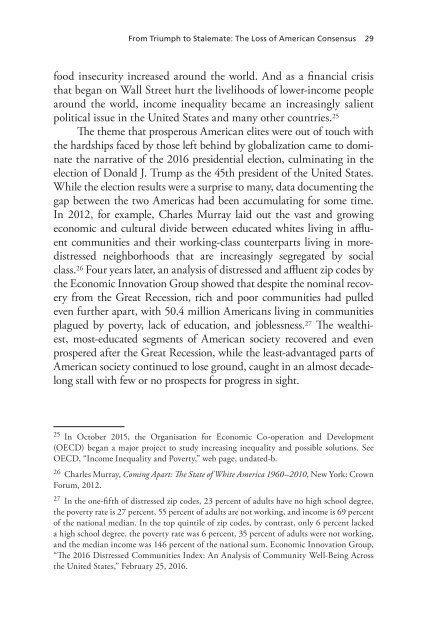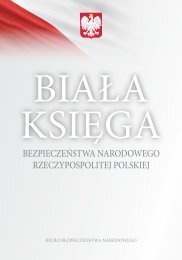You also want an ePaper? Increase the reach of your titles
YUMPU automatically turns print PDFs into web optimized ePapers that Google loves.
From Triumph to Stalemate: The Loss of American Consensus 29<br />
food insecurity increased around the world. And as a financial crisis<br />
that began on Wall Street hurt the livelihoods of lower-income people<br />
around the world, income inequality became an increasingly salient<br />
political issue in the United States and many other countries. 25<br />
The theme that prosperous American elites were out of touch with<br />
the hardships faced by those left behind by globalization came to dominate<br />
the narrative of the 2016 presidential election, culminating in the<br />
election of Donald J. Trump as the 45th president of the United States.<br />
While the election results were a surprise to many, data documenting the<br />
gap between the two Americas had been accumulating for some time.<br />
In 2012, for example, Charles Murray laid out the vast and growing<br />
economic and cultural divide between educated whites living in affluent<br />
communities and their working-class counterparts living in moredistressed<br />
neighborhoods that are increasingly segregated by social<br />
class. 26 Four years later, an analysis of distressed and affluent zip codes by<br />
the Economic Innovation Group showed that despite the nominal recovery<br />
from the Great Recession, rich and poor communities had pulled<br />
even further apart, with 50.4 million Americans living in communities<br />
plagued by poverty, lack of education, and joblessness. 27 The wealthiest,<br />
most-educated segments of American society recovered and even<br />
prospered after the Great Recession, while the least-advantaged parts of<br />
American society continued to lose ground, caught in an almost decadelong<br />
stall with few or no prospects for progress in sight.<br />
25 In October 2015, the Organisation for Economic Co-operation and Development<br />
(OECD) began a major project to study increasing inequality and possible solutions. See<br />
OECD, “Income Inequality and Poverty,” web page, undated-b.<br />
26 Charles Murray, Coming Apart: The State of White America 1960–2010, New York: Crown<br />
Forum, 2012.<br />
27 In the one-fifth of distressed zip codes, 23 percent of adults have no high school degree,<br />
the poverty rate is 27 percent, 55 percent of adults are not working, and income is 69 percent<br />
of the national median. In the top quintile of zip codes, by contrast, only 6 percent lacked<br />
a high school degree, the poverty rate was 6 percent, 35 percent of adults were not working,<br />
and the median income was 146 percent of the national sum. Economic Innovation Group,<br />
“The 2016 Distressed Communities Index: An Analysis of Community Well-Being Across<br />
the United States,” February 25, 2016.




